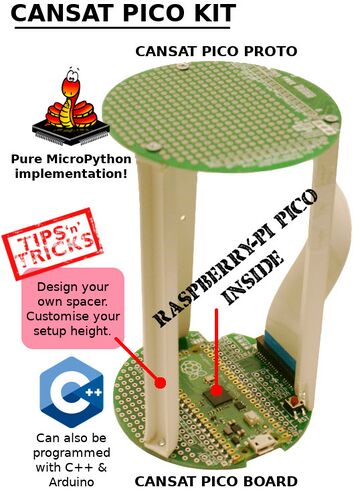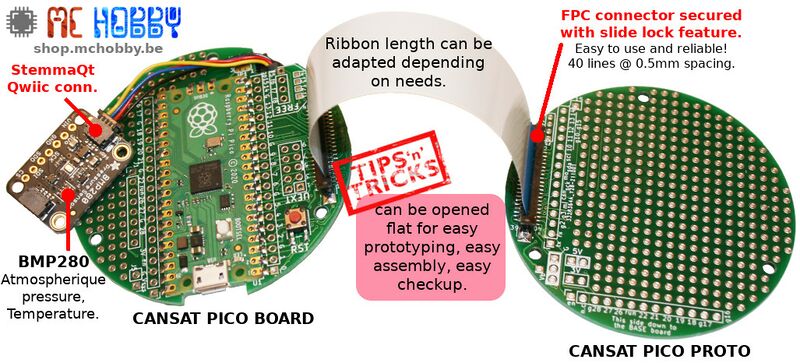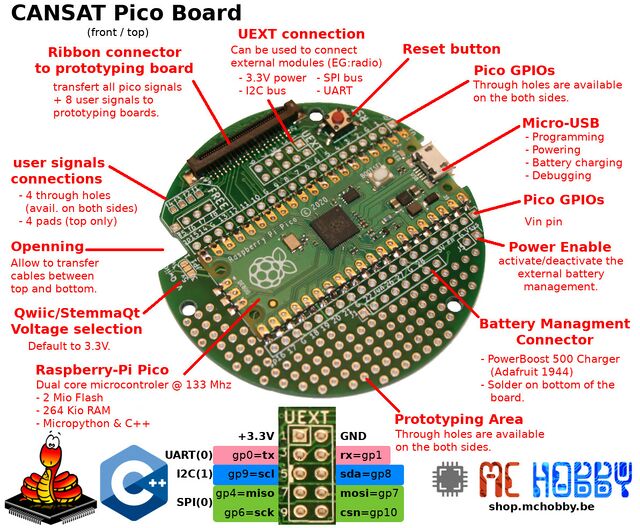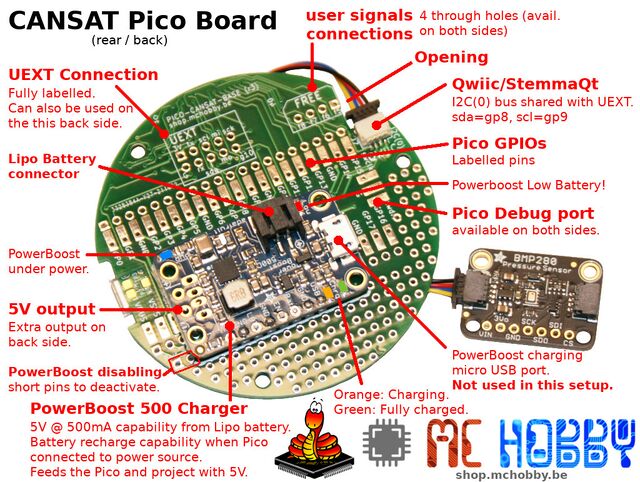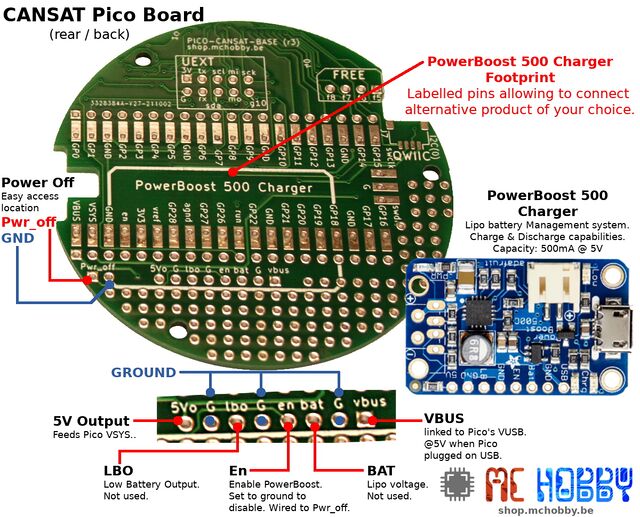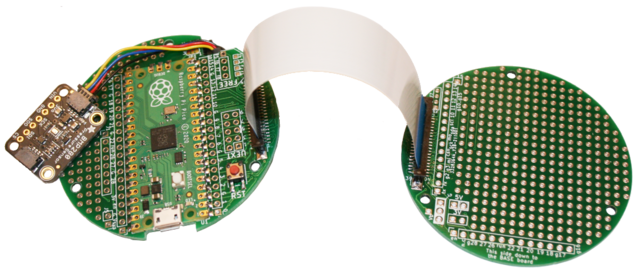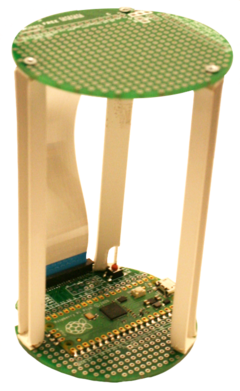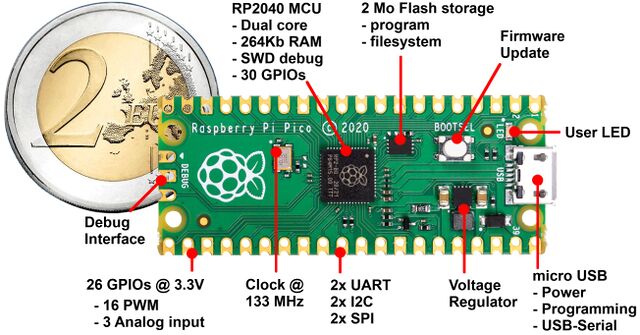Différences entre versions de « ENG-CANSAT-PICO-CONTENT »
| (26 versions intermédiaires par le même utilisateur non affichées) | |||
| Ligne 1 : | Ligne 1 : | ||
{{ENG-CANSAT-PICO-NAV}} | {{ENG-CANSAT-PICO-NAV}} | ||
| − | == Cansat Pico in few words == | + | == Cansat Pico kit in few words == |
The CanSat-Pico-Kit is build around the '''Raspberry-Pi Pico''' plateform. | The CanSat-Pico-Kit is build around the '''Raspberry-Pi Pico''' plateform. | ||
| − | |||
| − | <div style="margin: 15px 0; background: rgba(255,204,102,.3); display: block; padding: 15px 15px 15px 15px; -webkit-border-radius: 2px; -moz-border-radius: 2px; border-radius: 2px; border: 1px solid #ff9900;" > | + | The '''Raspberry-Pi Pico''' is a powerful dual core microcontroller created by the Raspberry-Pi foundation. The Pico goes far beyond the Arduino Uno in terms of power and capabilities. |
| + | |||
| + | It is distributed with the MicroPython firmware and can also be programmed with C++ and Arduino. | ||
| + | |||
| + | [[fichier:ENG-CANSAT-PICO-CONTENT-10.jpg|360px]] | ||
| + | |||
| + | <div style="margin: 15px 0; background: rgba(255,204,102,.3); display: block; padding: 15px 15px 15px 15px; -webkit-border-radius: 2px; -moz-border-radius: 2px; border-radius: 2px; border: 1px solid #ff9900;" >Just care about voltage, the '''Pico is 3.3V logic'''. Do not apply any voltage greater than 3.3V to any GPIO on the Pico.</div> | ||
| + | |||
| + | MicroPython is a very robust environment natively compiling and running python script. MicroPython fits a compiler, a python virtual machine and a file system to store the script. Thanks to MicroPython, everything learned with Python language or MicroPython boards can be applied to the Pico. | ||
| + | |||
| + | The kit is designed to ease the prototyping phase, it can be open flat on the desk to ease access to every logic signals and components/boards added to the initial setup. | ||
| + | |||
| + | [[fichier:ENG-CANSAT-PICO-CONTENT-11.jpg|800px]] | ||
| + | |||
| + | The "Cansat Pico Board" feature the Raspberry-Pi Pico and already embeeds useful and smart features to ease the prototyping and testing phase for your Cansat project. | ||
| + | |||
| + | When the kit was designed, we did forseen the fact that the project could either be: | ||
| + | * placed between the boards (inside). | ||
| + | * placed ouside of the boards and use a shorter ribbon (boards are enclosed right in the middle of the project). | ||
| + | |||
| + | We did also features a Qwiic/StemmaQt connector available underside. This very compact connector do features power and I2C bus. It can be used to quickly and safely connects toons of I2C capable sensors boards. | ||
| + | * [https://www.adafruit.com/category/1005 StemmaQT sensors] are available at [https://www.adafruit.com Adafruit Industries USA] and its distributor network. | ||
| + | * [https://www.sparkfun.com/qwiic#products Qwiic sensors] are available at [https://www.sparkfun.com SparkFun electronic USA] and its distributor network. | ||
| + | |||
| + | [[fichier:ENG-CANSAT-PICO-CONTENT-12.jpg|640px]] | ||
| + | |||
| + | Just flip over the "Cansat Pico Board" to discover additional features available underside the Pico. | ||
| + | |||
| + | As we can propotype under the board, it is also very important to have the board fully labelled this side. | ||
| + | |||
| + | [[fichier:ENG-CANSAT-PICO-CONTENT-13.jpg|640px]] | ||
| + | |||
| + | As the Raspberry-Pi Pico doesn't features Lipo battery circuitery, we do added a special connector to plug an [https://www.adafruit.com/product/1944 Adafruit PowerBoost 500 charger] on the board. | ||
| + | |||
| + | Just connect the Pico to you computer (or power it with a wall adapter) and the Lipo will auto-magically starts to charge-up. | ||
| + | |||
| + | Unplug your pico from computer and the PowerBoost charger will take over. The Lipo will discharge to power your project. | ||
| + | |||
| + | Thanks to the PowerBoost, your cansat projet do also have a 5V power rail (500 mA max). | ||
| + | |||
| + | Needs to spare energy? no problem, the "Power Off" pin is available near of the board boundary. Once the PWR_OFF tied to the ground, the PowerBoost is disabled (as Pico and the project). | ||
| + | |||
| + | [[fichier:ENG-CANSAT-PICO-CONTENT-14.jpg|640px]] | ||
=== Cansat Pico Kit content === | === Cansat Pico Kit content === | ||
| Ligne 13 : | Ligne 54 : | ||
[[fichier:ENG-CANSAT-PICO-CONTENT-01.png|640px]] | [[fichier:ENG-CANSAT-PICO-CONTENT-01.png|640px]] | ||
| − | Once assembled with spacer designed | + | Once assembled with spacer you designed, you do have a cylindrical development plateform with plenty of space. |
| − | + | ||
[[fichier:ENG-CANSAT-PICO-CONTENT-02.png|240px]] | [[fichier:ENG-CANSAT-PICO-CONTENT-02.png|240px]] | ||
| − | === Pico | + | You can develop your project: |
| + | * '''either''' in the inner space between the bottom and the top boards. | ||
| + | * '''either''' using smaller spacers to develop your project in the inner space {{underline|and}} also the outer space. | ||
| + | |||
| + | Outer space can also be used thanks to the through holes PCBs and the labelling the both sides of the PCBs. | ||
| + | |||
| + | === Pico Boards === | ||
| + | |||
| + | The Raspberry-Pi Pico is at the earth of this kit. One is soldered onto the Cansat Kit, the other is free for use to make prototyping or creating the receiving base station. | ||
| + | |||
| + | [[fichier:ENG-CANSAT-PICO-CONTENT-00.jpg|640px]] | ||
| − | [[ | + | See the [[ENG-CANSAT-PICO-USER-GUIDE|Cansat Pico User Guide]] section for more information on its integration. |
| − | See the [ | + | See the [https://www.raspberrypi.com/documentation/microcontrollers/ Official Pico MicroPython starter guide] for learning more about MicroPython on Pico. |
== Kit content == | == Kit content == | ||
| − | + | {{parts-begin}} | |
| − | {{parts- | + | {{parts-item |
| + | |name=Raspberry-Pi Pico | ||
| + | |descr=Dual core RP2040 MCU @ 133 MHz with 264Ko RAM & 2 Mo Flash. One Pico is used on the Cansat kit, the other is used for prototyping. | ||
| + | |img=RASPBERRY-PICO.png | ||
| + | |link=https://shop.mchobby.be/product.php?id_product=2025 | ||
| + | |qty=2 | ||
| + | }} | ||
| + | |||
| + | {{parts-item | ||
| + | |name=Cansat base dev. board for Pico | ||
| + | |descr=Solder a Pico onto it and drive your cansat project with MicroPython. | ||
| + | |img=PICO-CANSAT-BASE.png | ||
| + | |link=https://shop.mchobby.be/product.php?id_product=2275 | ||
| + | |qty=1 | ||
| + | }} | ||
| + | |||
| + | {{parts-item | ||
| + | |name=Cansat proto board | ||
| + | |descr=Prototyping board connected to the Pico GPIO. | ||
| + | |img=PICO-CANSAT-PROTO.png | ||
| + | |link=https://shop.mchobby.be/product.php?id_product=2272 | ||
| + | |qty=1 | ||
| + | }} | ||
{{parts-item | {{parts-item | ||
| − | |name= | + | |name=FPC ribbon |
| − | |descr= | + | |descr=This ribbon connects the base board to the proto board. |
| − | |img= | + | |img=FPC-RUBAN-100mm.png |
| − | |link=https://shop.mchobby.be/product.php?id_product= | + | |link=https://shop.mchobby.be/product.php?id_product=2278 |
|qty=1 | |qty=1 | ||
}} | }} | ||
| Ligne 39 : | Ligne 112 : | ||
{{parts-item | {{parts-item | ||
|name=USB A/microB 1m cable | |name=USB A/microB 1m cable | ||
| − | |descr=Can be used to plug your | + | |descr=Can be used to plug your pico on a computer to program it or to reload the Lipo. |
|img=CABLE-USB-MICRO.png | |img=CABLE-USB-MICRO.png | ||
|link=https://shop.mchobby.be/product.php?id_product=145 | |link=https://shop.mchobby.be/product.php?id_product=145 | ||
| Ligne 62 : | Ligne 135 : | ||
{{parts-item | {{parts-item | ||
| − | |name= | + | |name=PowerBoost 500 charger |
| − | |descr= | + | |descr=Convert a Lipo battery power into usable 5V power source. This board can also reload the Lipo when the kit is powered via USB. |
| − | |img= | + | |img=POWERBOOST-500-CHARGER.png |
| − | |link=https://shop.mchobby.be/product.php?id_product= | + | |link=https://shop.mchobby.be/product.php?id_product=534 |
|qty=1 | |qty=1 | ||
}} | }} | ||
{{parts-item | {{parts-item | ||
| − | |name= | + | |name=Alternative to Powerboost 500 charger |
| − | |descr= | + | |descr=Also convert Lipo battery power into usable 5V power. This board can also reload the Lipo when the Kit is powered via USB. |
| − | |img= | + | |img=POWERBOOST-1000-CHARGER-SPARKFUN.jpg |
| − | |link=https://shop.mchobby.be/product.php?id_product= | + | |link=https://shop.mchobby.be/fr/regulateurs/2508-powerboost-1000-chargeur-3232100025080-adafruit.html |
| + | |qty=0 | ||
| + | }} | ||
| + | |||
| + | {{parts-item | ||
| + | |name=Lithium Polymer Battery | ||
| + | |descr=Transform the Feather into an autonomous plateform with this 1300mAh Lipo. | ||
| + | |img=ACC-LIPO-1.3Ah.png | ||
| + | |link=https://shop.mchobby.be/product.php?id_product=277 | ||
|qty=1 | |qty=1 | ||
}} | }} | ||
{{parts-item | {{parts-item | ||
| − | |name= | + | |name=JST-SH fast connexion wire |
| − | |descr= | + | |descr=This 100mm wire can be used to connect Qwiic or StemmaQt board to the Pico in a snap |
| − | |img= | + | |img=FIL-JSTSH4-100mm.png |
| − | |link=https://shop.mchobby.be/product.php?id_product= | + | |link=https://shop.mchobby.be/product.php?id_product=2112 |
|qty=1 | |qty=1 | ||
}} | }} | ||
| Ligne 87 : | Ligne 168 : | ||
{{parts-item | {{parts-item | ||
|name=BMP280 – Barometric pressure sensor | |name=BMP280 – Barometric pressure sensor | ||
| − | |descr=Easily evaluate pressure, altitude and temperature. | + | |descr=Easily evaluate pressure, altitude and temperature. This board expose a StemmaQt connector |
| − | |img= | + | |img=BMP280v2.png |
|link=https://shop.mchobby.be/product.php?id_product=1118 | |link=https://shop.mchobby.be/product.php?id_product=1118 | ||
|qty=1 | |qty=1 | ||
Version actuelle datée du 3 novembre 2022 à 22:50
Cansat Pico kit in few words
The CanSat-Pico-Kit is build around the Raspberry-Pi Pico plateform.
The Raspberry-Pi Pico is a powerful dual core microcontroller created by the Raspberry-Pi foundation. The Pico goes far beyond the Arduino Uno in terms of power and capabilities.
It is distributed with the MicroPython firmware and can also be programmed with C++ and Arduino.
MicroPython is a very robust environment natively compiling and running python script. MicroPython fits a compiler, a python virtual machine and a file system to store the script. Thanks to MicroPython, everything learned with Python language or MicroPython boards can be applied to the Pico.
The kit is designed to ease the prototyping phase, it can be open flat on the desk to ease access to every logic signals and components/boards added to the initial setup.
The "Cansat Pico Board" feature the Raspberry-Pi Pico and already embeeds useful and smart features to ease the prototyping and testing phase for your Cansat project.
When the kit was designed, we did forseen the fact that the project could either be:
- placed between the boards (inside).
- placed ouside of the boards and use a shorter ribbon (boards are enclosed right in the middle of the project).
We did also features a Qwiic/StemmaQt connector available underside. This very compact connector do features power and I2C bus. It can be used to quickly and safely connects toons of I2C capable sensors boards.
- StemmaQT sensors are available at Adafruit Industries USA and its distributor network.
- Qwiic sensors are available at SparkFun electronic USA and its distributor network.
Just flip over the "Cansat Pico Board" to discover additional features available underside the Pico.
As we can propotype under the board, it is also very important to have the board fully labelled this side.
As the Raspberry-Pi Pico doesn't features Lipo battery circuitery, we do added a special connector to plug an Adafruit PowerBoost 500 charger on the board.
Just connect the Pico to you computer (or power it with a wall adapter) and the Lipo will auto-magically starts to charge-up.
Unplug your pico from computer and the PowerBoost charger will take over. The Lipo will discharge to power your project.
Thanks to the PowerBoost, your cansat projet do also have a 5V power rail (500 mA max).
Needs to spare energy? no problem, the "Power Off" pin is available near of the board boundary. Once the PWR_OFF tied to the ground, the PowerBoost is disabled (as Pico and the project).
Cansat Pico Kit content
The Cansat Pico Kit is designed to be compact, evolutive, customisable, sizable (in height) and programmed in Python (thank to MicroPython).
Once assembled with spacer you designed, you do have a cylindrical development plateform with plenty of space.
You can develop your project:
- either in the inner space between the bottom and the top boards.
- either using smaller spacers to develop your project in the inner space and also the outer space.
Outer space can also be used thanks to the through holes PCBs and the labelling the both sides of the PCBs.
Pico Boards
The Raspberry-Pi Pico is at the earth of this kit. One is soldered onto the Cansat Kit, the other is free for use to make prototyping or creating the receiving base station.
See the Cansat Pico User Guide section for more information on its integration.
See the Official Pico MicroPython starter guide for learning more about MicroPython on Pico.
Kit content
| Description | Quantité | |
Raspberry-Pi Pico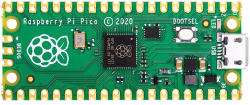
|
Dual core RP2040 MCU @ 133 MHz with 264Ko RAM & 2 Mo Flash. One Pico is used on the Cansat kit, the other is used for prototyping. disponible ici chez MCHobby |
2 |
Cansat base dev. board for Pico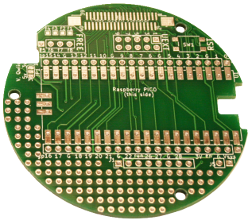
|
Solder a Pico onto it and drive your cansat project with MicroPython. disponible ici chez MCHobby |
1 |
Cansat proto board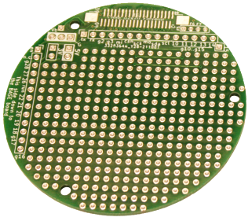
|
Prototyping board connected to the Pico GPIO. disponible ici chez MCHobby |
1 |
FPC ribbon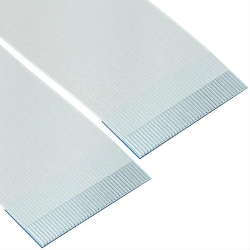
|
This ribbon connects the base board to the proto board. disponible ici chez MCHobby |
1 |
USB A/microB 1m cable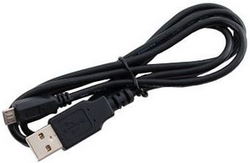
|
Can be used to plug your pico on a computer to program it or to reload the Lipo. disponible ici chez MCHobby |
1 |
Half Size Breadboard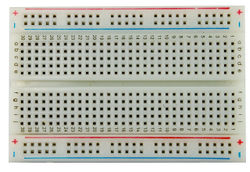
|
Solderless breadboard are used for fast prototyping. disponible ici chez MCHobby |
1 |
Multi-functional breadboard wires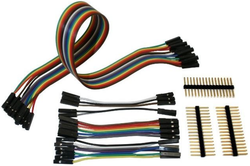
|
Set of wires with plug that can be modified from female to male. disponible ici chez MCHobby |
1 |
PowerBoost 500 charger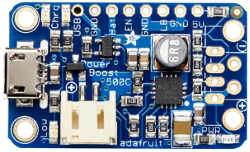
|
Convert a Lipo battery power into usable 5V power source. This board can also reload the Lipo when the kit is powered via USB. disponible ici chez MCHobby |
1 |
Alternative to Powerboost 500 charger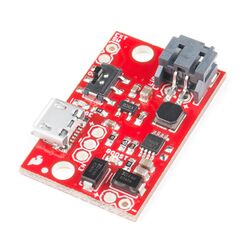
|
Also convert Lipo battery power into usable 5V power. This board can also reload the Lipo when the Kit is powered via USB. disponible ici chez MCHobby |
0 |
Lithium Polymer Battery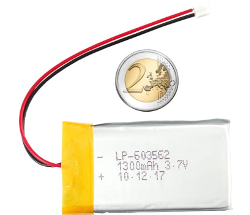
|
Transform the Feather into an autonomous plateform with this 1300mAh Lipo. disponible ici chez MCHobby |
1 |
JST-SH fast connexion wire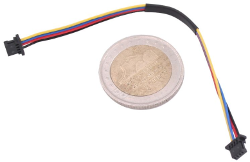
|
This 100mm wire can be used to connect Qwiic or StemmaQt board to the Pico in a snap disponible ici chez MCHobby |
1 |
BMP280 – Barometric pressure sensor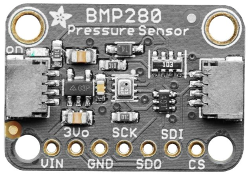
|
Easily evaluate pressure, altitude and temperature. This board expose a StemmaQt connector disponible ici chez MCHobby |
1 |
TMP36 – analog temperature sensor
|
Transform the sensor voltage read on analog input into an easy-to-read temperature. disponible ici chez MCHobby |
1 |
RFM69HCW Transceiver Radio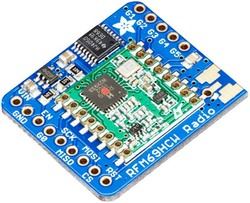
|
Transport data over long distance with packet radio. One breakout act as emitter, the second one as receiver. disponible ici chez MCHobby |
2 |
Written by Meurisse D. for MCHobby
